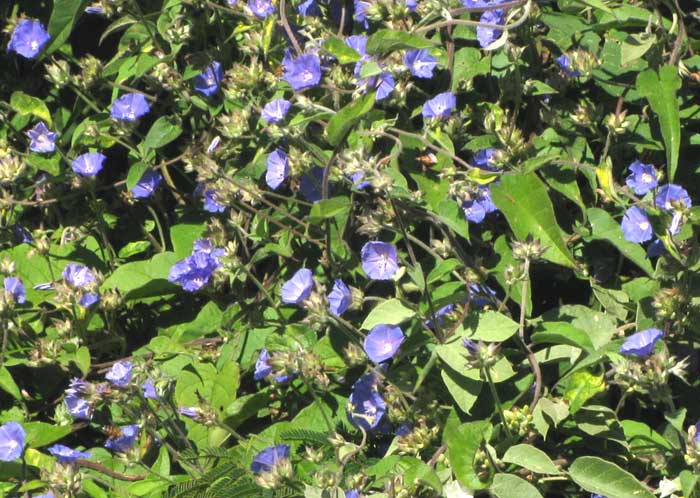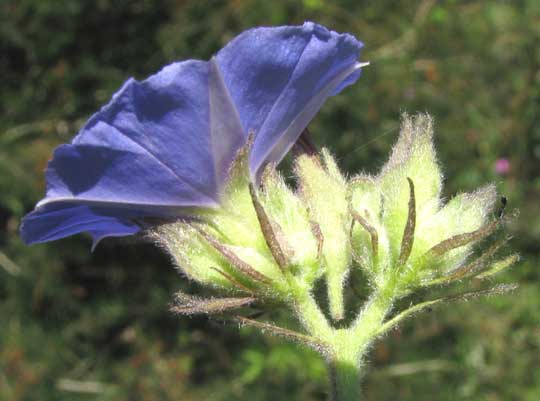Excerpts from Jim Conrad's
Naturalist Newsletter

from the November 21, 2010 Newsletter issued from Hacienda Chichen Resort beside Chichén Itzá Ruins, central Yucatán, MÉXICO; limestone bedrock, elevation ~39m (~128ft), ~N18.52°, ~W95.15°
BLUE JACQUEMONTIAS
Cruising the Yucatán's weedy backroads at this time of year morning-glories simply bedazzle the eye. There are many kinds of them, with different flower colors and sizes and leaf shapes, and great numbers of the various kinds. For the most part they're weeds, but because of the color they lend the landscape and the bounty of nectar they provide pollinators, you're glad to see them, wishing them well.
One of the most abundant species nowadays forming thick blankets of mutually entangling, blue-flowered vines mantling bushes and low trees is shown above. That's a tiny part of a mass covering an area larger than most gringo lawns, and it's hard to see how the shrubs and trees below them get enough light to stay alive. It was impressive.
This member of the Morning-Glory Family, the Convolvulaceae, is JACQUEMONTIA TAMNIFOLIA, so widely distributed in the American and African tropics that it's hard to say where it's native to. It's even fairly common in places throughout the US Southeast, and seems poised to move north with global warming. It was first noted in Missouri, for instance, only in 1979, but now is more commonly met with.
Most vines known as morning-glories are members of the large genus Ipomoea so, if you're a morning-glory purist, Jacquemontias aren't really morning-glories. Often in the US they're just called Jacquemontias, but Mexico is home to about 17 species of that genus so, since this is the common, blue one, I call it the Blue Jacquemontia.
How do you distinguish a real morning-glory -- a member of the genus Ipomoea -- from a Jacquemontia? One way is that the stigmas of Ipomoeas are more or less spherical, while stigmas of Jacquemontias are two-lobed, with each lobe being somewhat slender, giving the style/stigma ensemble above the ovary a T shape. Can you make out the two-lobed stigma in the Jacquemontia throat, residing among five stamens, below?

Jacquemontia tamnifolia differs from other Jacquemontias in the way its flowers are bunched into such close heads, and there are slender bracts, or modified leaves, subtending each flower, as shown below:

Back in Yokdzonot a few miles west of here, in 2008 we ran into another Jacquemontia, Jacquemontia nodiflora. You might enjoy comparing that white-flowered species, paying special attention to its similar T-shaped style and stigma, with the current blue-flowered one, at www.backyardnature.net/yucatan/jacquemo.htm.